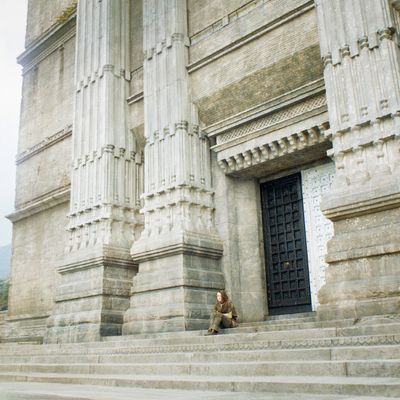
“Welcome to the House of Black and White! Hide your eyes!” This is how Game of Thrones executive story editor Bryan Cogman introduces the set at Belfast’s Titanic Studios, where the interiors of the show’s latest location are shot. Inside, it’s a mysterious space, of which Maisie Williams’s character Arya gets to see only a corner in the most recent episode (more will be revealed as the season progresses). But what goes on here? Why do people visit it, and tremble at those who work there?
Here’s what you need to know about the House of Black and White, and its guild of assassins, the Faceless Men. Spoilers ahead.
It’s a temple unlike any other. It includes religious iconography from a number of faiths, worshipped by different people. Arya recognizes a few, but here are some of the ones you see at the beginning of the episode: the Weeping Woman of Lys, mostly visited by old women; the Lion of Night, a punishing god of Essos, mainly visited by rich men; the Black Goat, a defending god of Essos who requires blood sacrifice; the fiery heart of R’hllor, Melisandre’s Lord of Light (read up on the religions on Game of Thrones here).
All the gods of these faiths represent the same thing — death. Death is considered a blessing to some, and for those who wish to receive it, they can come to the House of Black and White and drink from its poisoned pools, as we saw a supplicant do in this episode. “It’s a real gift, for people who are hopeless, who come and want to die,” Tom Wlaschiha, who plays Jaqen H’ghar, said. “It’s a bit like assisted suicide! We’re going to see more of that this season, and it will be explained further.” (Along with what happens to their bodies.)
Since it’s a place that is meant for both prayer and peaceful deaths, it’s quieter than your average temple. “It’s an amazing set,” Wlaschiha said. “The stillness once the cameras were rolling, you could have heard a pin drop. I found myself automatically lowering my voice, like in a real church.”
It houses the Faceless Men (some of whom are women, too). The House of Black and White doubles as a space for clandestine meetings, because within its walls, among the priests and the acolytes, is this cult of assassins. This select group who worships the god of Death also gives its gift to those who aren’t seeking it — they believe they’re providing an act of mercy, while others would call them mercenaries. Their services come at a price, which varies depending on the target: A king would cost more than a peasant. When King Robert wishes to kill Daenerys Targaryen, a discussion that wasn’t included in the show, they shoot down the option of hiring a Faceless Man as too expensive. Jaqen H’ghar’s initial offer to Arya, then — three deaths, anyone she chooses — is actually a pretty big deal. Only a handful of people in Westeros could pay for that.
The Faceless Men do not choose their targets. It’s not personal. (The key was that Arya had to pick the names.) As they say, they are “no one.” Self-abnegation and elimination of ego allow them to serve their god. Arya has to let go of comfort — the Faceless Men lead an ascetic life, so her bedroom is like a little cell. (At least for now — she’s just an apprentice and hasn’t been privy to all their rooms just yet). And if Arya becomes “no one,” she’d have to abandon more than her belongings — she’d have to abandon her Kill List, too. “It’s a lot harder to let go of your own personal hate, your own issues, than she thinks,” Maisie Williams said.

